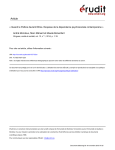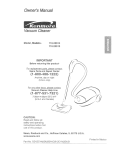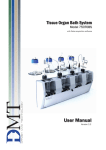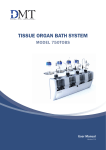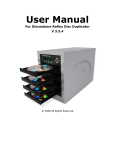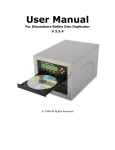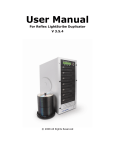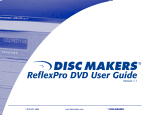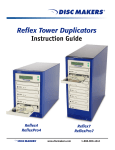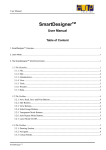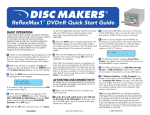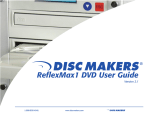Download Disc Makers 1 User guide
Transcript
Chapter 1: Overview 1. Welcome The Disc Makers Forte autoloader is a reliable, high performance, high speed, standalone, robotic DVD and/or CD autoloader. With its professional industrial design and simple user interface, it makes your duplicating experience easier than ever. With the Disc Makers Forte, you can have a capacity from 1 to 25 discs, duplicate continuously (even with multiple masters), and get the highest quality duplication, all at an extremely affordable price. The Disc Makers Forte is the most reliable and affordable autoloader on the market. Before you start using this autoloader, please read the following to ensure proper operation: DVD Duplication Limitations The DVD autoloader will not copy any DVDs that have Copy Protection encoded in the content. Typically, most DVDs you purchase or rent from a store contains Copy Protection. In addition to the copy protection limitation, the autoloader will only copy a DVD5 format (4.7 GB) disc to another DVD5 format recordable DVD media. If your autoloader has double layer/dual layer capability, you can copy a DVD9 format (8.5 GB) disc to another DVD9 format recordable DVD media, but you cannot duplicate a DVD5 format disc on to a DVD9 format recordable media or vice versa. Temperature Warning If the autoloader was stored in a location where the temperature dropped below 32° F (0° C) within the past 24 hours, leave the autoloader in a warm room with temperatures at least 65° F (19° C) for four hours prior to powering it on for the first time. Failure to do so may cause irreparable harm and prevent the autoloader from functioning. Maintenance It is very important to operate and keep the autoloader in a dust free, clean environment since dust is the number one killer of CD/DVD recording devices. Failure to do so can severely damage your autoloader. We strongly suggest that you constantly use an Air Duster (Canned Air) to clear off any dust on the surface of the autoloader. Note: Do not try to use an Air Duster to clean the autoloader while the writer trays are open. In doing so, you may inadvertently blow dust into the recording device and damage it. Proper Shutdown To avoid possible system failures, you need to shut down the autoloader properly. To shut down the autoloader use the Shutdown hot key and follow the instructions on the screen. Not performing this function increases the risk of damaging the autoloader. Spindles vs. Bins The Disc Makers Forte has 1 bin for holding blank CDs and/or DVDs. Although the manual may refer to them as spindles at times, many of the messages shown on the LCD display refer to them as bins in order to create more concise messages. Don’t panic. Spindles and bins are the same. User Guide v.1.0 www.discmakers.com/techsupport 2 2. The LCD Control Panel Figure 1-4 below shows the LCD Control Panel. This panel has a two-line by 20 character LCD display to provide user feedback and eight push buttons to control the of the Disc Makers Forte operation. The functions for these buttons are shown in Table 1-1. Figure 1-4 LCD Control Panel Layout 3. Menu Overview This section provides an overview of the menu options. These menu options are explained in detail on the referenced pages. User Guide v.1.0 www.discmakers.com/techsupport 3 1. Copy: page 10 Use the Copy menu to make copies of a master disc or hard drive image. Before you start a copy, make sure you have selected the correct Master Mode. If you plan to use Single Master Mode, please make sure you have successfully loaded your master disc to a partition on the Hard Drive. If you plan to use Multi Master Mode, please make sure you have placed every master disc on top of the corresponding number of blank discs. For additional information, see Making Copies in Single Master Mode on page 14 or Making Copies in Multi Master Mode on page 16. 2. Test: page 14 Use the Test menu to simulate the copy process. With simulation, write once recordable discs such as DVD-R, or CDR will be reusable. The purpose of simulation is to ensure error free duplication. Note: Due to physical limitations of the DVD+R recordable format, you can not test or simulate the DVD+R copy format. Warning: If you are using CD/DVD Rewritable discs as your blank media during the simulation, the content on those discs will be permanently erased. 3. Compare: page 14 Use the Compare function to perform a bit-by-bit comparison between the content of your master disc(s) in the Hard Drive and the contents of all discs it copied. This ensures that all of your copies are identical to original master disc(s). Note: The bit-by-bit comparison will only apply on all DVDs and Data CDs. The readability check will be applied for other formats like Audio CDs, CD+G, and Video CDs discs due to their lack of error correction mechanisms. 4. Test + Copy page 14 Use the Test + Copy menu option to simulate the copying process initially. Then, the autoloader performs the actual copy process on the blank disc(s) that passed the simulation. For the blank disc(s) that didn t pass the simulation, the autoloader will place it/them to the Reject Area. 5. Copy + Compare page 14 Use the Copy + Compare menu option to make 100% reliable copies. After the copy process is done, the autoloader automatically compares the copies from the content of your original master disc. Note: The bit-by-bit comparison will only apply on all DVDs and Data CDs. The readability check will be applied for other formats like Audio CDs, CD+G, and Video CDs discs due to their lack of error correction mechanisms. 6. Select Burn Speed page 14 Use the Select Burn Speed menu option to adjust the duplication speed for the various blank disc formats. 7. Select Source page 14 Use the Select Source menu to tell the system where the content of the master disc resides during User Guide v.1.0 www.discmakers.com/techsupport 4 duplication. At this point, Hard Drive is the only place where the content of the master disc resides during duplication. 8. Master Mode page 16 Use the Master Mode menu to select either Single Master Mode(SM) or Multi Master Mode (MM). 9. Erase page 16 Use the Erase RW menu to erase your Rewritable discs. There are two options: a. Full Erase: This option erases the entire disc, destroying all previously written data in the process. b. Quick Erase: This option erases the index (TOC) of the Rewritable disc, not the data section. It is much faster than Full Erase. However, the data section is still recoverable. If you prefer the old content not to be recovered for security purpose, please perform Full Erase. 10. Hard Drive Setup: page 17 Use the Hard Drive Setup menu to perform various hard drive-related operations. These options include loading, renaming, or deleting your images. 11. Setup page 20 Use the Setup menu options to control how the autoloader operates. You can scroll between the various options using the Up or Down button. 1. Language Use this setting to choose the language used to navigate the autoloader. The autoloader supports English and Spanish menus. 2. Read Error Skip Normally, when the autoloader encounters a read error while reading the master disc, all the duplication will be aborted and all the recordable media in the writers will be ruined. However, if you believe that your master disc has a small, insignificant error due to physical damage, you can enable this setting to allow the autoloader to skip any read errors that it encounters. It is ON by default. Important: This function does not fix the error; it only skips it to continue copying the rest of the readable data. This function is recommended for Video and Audio duplication purposes. 3. CD Writing Mode Use this setting to select the mode you would like use to duplicate a CD. There are two different modes: Disc at Once and Track at Once. Disc at Once is recommended for duplication. 4. Max Audio, VCD & CDG Speed Due to the lack of error checking mechanism for Audio CD, Video CD and CD+G format, duplicating them at too high a speed can cause frequent errors like glitches and skips. Use this setting to adjust the maximum duplication speed for Audio, Video CD and CD+G format to ensure the reliable duplication for such formats. 5. Buzzer Use this setting to choose whether you want to hear a beep when you press a button and when a task has been completed. 6. Startup Menu Use this setting to choose which menu you would like to see first when you turn on the autoloader. User Guide v.1.0 www.discmakers.com/techsupport 5 7. Screen Saver Use this setting to enable or disable the Screen Saver feature. When this is enabled, a screen saver is displayed whenever your autoloader has been idle for a long period of time. 8. Counter Use the Counter menu to enable or disable the Counter feature. The counter tells you how many discs have been copied and how many discs are left to go during the progress and it will stop the job once the desired number of copies has been made. 9. DVD+R High Compatibility Mode This feature allows you to turn the DVD+R High Compatibility Mode feature ON or OFF. The purpose of this feature is to increase the compatibility of DVD+R media with a broader range of DVD Video players. 10. ISRC If your master Audio CD contains ISRC codes and you would like them to copy to your duplicates, enable this option. 11. Disable Drives Use this utility to allow the system to disable certain drives/trays when certain drives/trays are producing high failure rates. See Disable Drives. 12. CD Overburn – (NOT RECCOMENDED) Enabling this option will attempt to record past the traditional 700 MB limit of a CD-R, but at the expense of increased failure rate and decreased compatibility. 12. System Utilities page 23 1. Disc Info Use the Disc Info utility to identify the type of blank recordable media. This utility identifies your blank recordable Media's format, capacity, manufacture ID, and the Media's certified writing speed. 2. System Info Use this menu option to see data about the autoloader and its resources (firmware version, RAM and CPU). 3. Device Info Use this menu option to see data about the drives that are installed in the autoloader. 4. Load Default Use this menu option to reset all of the options back to the manufacturer's default values. You can use this function if your autoloader is acting abnormally. 5. Update Firmware Use this utility to update the software in your autoloader. To update, insert the manufacturer s Certified Update CD into the writer drive. Then you can press the Enter button to update. Important: You should not upgrade your autoloader's firmware unless your system is becoming unstable or you are advised to do so by Tech Support. 13. Loader Utilities page 24 Use the Loader Utilities menu options to access the various utilities built into the autoloader. 1. Update Loader Firmware User Guide v.1.0 www.discmakers.com/techsupport 6 This function is used to update the firmware of your robotics, if instructed by technical support personnel. 14. Shutdown Use this menu option to turn off your system. Once you see the Ready to Power Off message, you can safely turn off the machine using the power switch. Turning off your autoloader without performing this function increases the risk of damaging it. 4. Single Master and Multi Master Modes There are two ways to make copies using the autoloader: Single Master Mode: This mode requires that a single master disc is loaded onto the hard drive prior to initiating the duplication process. This mode is ideal if your job involves one or very few master disc(s). Multi Master Mode (Batch Mode): This mode does not require you to manually load your master. Simply place the master disc(s) on top of the stack of blank discs needed for that particular job of the master disc. This mode is ideal if you have numerous master discs and fewer copies for each master disc. The Multi Master mode uses the Reserve partition to temporarily store the content of the current master disc. Once the task is complete and a new master disc has been detected, the reserve partition's content (of previous master disc) will be replaced with the content of the new master disc. You can tell immediately which mode you are in by looking at any of the Copy or Test menus: The (SM) indicates Single Master Mode, and the (MM) indicates Multi Master Mode. For example, if you need to make: • • • 2 copies of job A 4 copies of job B 3 copies of job C Under Multi Master Mode, you would need to follow steps below: 1. 2. 3. 4. 5. 6. 7. Make sure all of the spindles are empty. Place 3 blank discs for job C on to the input spindle. Place the master disc for job C on top of those blank discs for job C. Place 4 blank discs for job B on top of the master disc for job C. Place the master disc for job B on top of those blank discs for job B. Place 2 blank discs for job A on top of the master disc for job B. Place the master disc for job A on top of those blank discs for Job A. After you have completed these steps, the Input Spindle should be loaded in the order shown in the figure above. When you start the copy operation, the robotic arm will pick up discs from the Input Spindle and place them into the drives. If any of the discs in the drives contains data, (in this case, that would be the first disc, the Master Disc User Guide v.1.0 www.discmakers.com/techsupport 7 for job A) the autoloader will load entire content of this disc(Master A) into the reserve partition on the Hard Drive. The subsequent discs from the input bin/spindle will be loaded in the empty drives. Once the loading process is completed, the autoloader will start the duplication process for the blank media in the remaining drives. Master disc A will be picked up from the appropriate drive and dropped on to the Output Spindle and the empty drive where the master disc was removed will be loaded with the next disc from the input bin. If a new master is detected before the previous job is finished, the autoloader will complete the first job, unload the completed job, and fill the drive trays with blank discs for the next job. The robotic arm will continue to load media into the drives as the duplicated discs are placed in the Output Spindle. Once the writer drive detects another Master disc, the same process is repeated for the new Master disc. 5. Setting Counters and Assigning Names Two frequently used tasks are setting counters and assigning names to partitions. Directions for these tasks are given here. 5.1 Setting Counters The autoloader frequently gives you the option to set a counter so that the machine can keep track of the number of copies made. Follow these steps when you see a Counter Selection Menu: The Counter Selection Menu lets you set how many copies you want to make for your project. The Counter Selection feature tells the autoloader to count the number of successful copies you have made and stop the job when the desired number of copies has been reached. You can select “No Counter” if you prefer to copy continuously with no interruption. (It will still count the number of copies, but it will not notify you when to stop.) To select the “No Counter” simply press the Enter button when you see the screen above. Or, you can select Specify Counter between 1 to 9999 by pressing the Up or Down button to go to the Specify Counter menu: Press the Enter button to select this option. You will see the next Specify Counter menu. To specify the number of copies for your project, you need to enter/input a four-digit number. If you need to specify a number that is less than four digits, fill the leading spaces with zeros (any leading zeros will be skipped). Examples of four-digit numbers are 0234 (two hundred and thirty four), or 0010 (ten). User Guide v.1.0 www.discmakers.com/techsupport 8 To enter the number, you need to use the Up or Down button to select the number for each digit and use the Enter button or the ESC button to move the cursor position right or left. Once you've finished, move the cursor to OK and press the Enter button. For example, if you want to specify a counter value of 21 (twenty one). The 4digit value would be 0021. To input the desired quantity, do the following: • Press the Down button repeatedly until “0” is displayed. • Press Enter button once to move the cursor to the next position. • Press the Down button repeatedly until “0” is displayed. • Press Enter button once to move the cursor to the next position. • Press the Down button repeatedly until “2” is displayed. • Press Enter button once to move the cursor to the next position. • Press the Down button repeatedly until “1” is displayed. • Now, “0021” is displayed, press Enter button once and the cursor moves to OK Then, press the Enter button once to submit your counter value. The loader will now start loading disc from the input spindles and place them into all drive trays. 5.2 Editing Names When you create either a new user or a partition, you need to assign a name to it. The example shown here shows how to name or rename a partition. During the process of creating a new partition, you will see the Edit Partition Name menu: To enter the name, use the Up or Down button to select the character and use the Enter or ESC button to move the cursor position. Once you've finished, move the cursor to “OK” and then press the Enter button. The name for a partition can be up to eight characters long, and the characters can be any alpha (A...Z) or numeric (0...9) value. For example, if you want to name the partition for your master disc as “FUN” then follow this example: • Press the Down button repeatedly until F is displayed. (You can also hold the Down button down, • and the autoloader will scroll through the alphabet.) • Press the Enter button once to move the cursor to the next position. • Press the Down button repeatedly until U is displayed. • Press the Enter button once to move the cursor to the next position. • Press the Down button repeatedly until N is displayed. • Press the Enter button once to move the cursor to the next position. • Once you have the name FUN displayed and then, press the Enter button repeatedly until the • cursor is moved to OK . • Then press the Enter button once to submit your name selection. You will now see the following confirmation screen: Press the Enter button to confirm. User Guide v.1.0 www.discmakers.com/techsupport 9 Chapter 2: Operation This chapter shows each of the menu options and how they are used. 1. Copy The Copy menu option or the front panel Copy quick key have two different modes of operation: a. Single Master Mode: This mode requires that a single master disc is loaded onto the hard drive prior to initiating the duplication process. This mode is ideal if your job involves one or very few master disc(s). b. Multi Master Mode (Batch Mode): This mode does not require you to manually load your master. Simply place the master disc(s) on top of the stack of blank discs needed for that particular job of the master disc. This mode is ideal if you have numerous master discs and fewer copies for each master disc. These modes are described in detail in “Single Master and Multi Master Modes” on page 7. If you are making copies in Single Master Mode, continue on to the next section. If you are making copies in Multi Master Mode, jump ahead to “Making Copies in Multi Master Mode” on page 12. 1.1 Making Copies in Single Master Mode This process will copy your master disc on to several blank discs simultaneously. This mode requires that your master disc is loaded into a partition on the Hard Drive. See “Load Partition” on page 18 for instructions on how to do this. Turn on your autoloader and wait until it has booted up. It should take a minute for the autoloader to go through its self adaptive test and auto-calibration procedures. You should see the following signifying your autoloader is ready: Make sure the Master Mode is set to Single Master mode (SM). If it is not, use the Up or Down button to navigate to the 8. Master Mode screen. If it is already in Single Master mode (SM), please skip to the step that starts the copy process. Press the Enter button to enter the Master Mode Menu and you will see a screen similar to one of the following: Use the Up or Down button to select Single Master Mode. Press the Enter button to submit your selection. Go back to the 1. Copy Menu. Use the Up or Down button to navigate to the following screen: Start the Copy Process. Insert your blank discs on to the Input Spindle(s) and press the Enter button to enter the 1. Copy menu. You will see the User Guide v.1.0 www.discmakers.com/techsupport 10 Choose Partition menu: Use the Up or Down button to find the partition where your master disc is stored. Press the Enter button to select that Partition. Next, you will see the Counter Selection menu: Follow the instructions shown in Setting Counters on page 12 to continue. Once the counters have been set, press the Enter button to confirm. You will see the Processing screen: After a short interval, the robotic loader will pick the top disc from the input spindle and place it into the drive. After two or three seconds of processing time, one of the following Copy Progress screens will appear. or Note: It is normal to see the progress indicator stay at 0%-10% and 100% for approximately 30 seconds for CD duplication and up to one minute for DVD duplication. That is caused by the initializing and finalizing stages. Once the duplication run is completed, the loader will remove the finished disc from the drive and place the successful copy on the Output Spindle and if there are any bad/NG copies the process will pause and requires user intervention to remove the bad disc. The loader will then pick up another blank disc and load it into the drive. This is then repeated for each disc. If you run out of blank discs and the job is not complete, the autoloader will give you an opportunity to fill the spindle: Important: When you add discs to the input spindle, be sure to remove your finished discs from the User Guide v.1.0 www.discmakers.com/techsupport 11 Output Spindle. At this point you can either put more discs on to the input spindle and press the Enter button to continue, or press the ESC button to terminate your project. Once the autoloader is through, you will see the following screen: OK: Indicates the number of successful copies. NG: Indicates the number of “Not good” copies. NB: Indicates the number of “Not Burned” discs in the drive. 1.2 Making Copies in Multi Master Mode This mode does not require you to manually load your master. Simply place the master disc(s) on top of the stack of blank discs needed for that particular job of the master disc. This mode is ideal if you have numerous master discs and fewer copies for each master disc. The Multi Master mode uses the Reserve partition to temporarily store the content of the current master disc. Once the task is complete and a new master disc has been detected, the reserve partition's content (of the previous master disc) will be replaced with the content of the new master disc. For more information on Multi Master Mode, see Single Master and Multi Master Modes on page 7.. Turn on your autoloader and wait until it has booted up. It should take several minutes for the autoloader to go through its self adaptive test and auto-calibration procedures. You should see the following signifying your autoloader is ready: Turn on your autoloader and wait until it has booted up. It should take several minutes for the autoloader to go through its self adaptive test and auto-calibration procedures. You should see the following signifying your autoloader is ready: Make sure the Master Mode is set to Multi Master mode (MM). If it is not, use the Up or Down button to navigate to the 8. Master Mode screen. If it is already in Multi Master mode (MM), please skip to the step that starts the copy process. Press the Enter button to enter the Master Mode Menu and you will see a screen similar to one of the following: Use the Up or Down button to select Single Master Mode. Press the Enter button to submit your selection. User Guide v.1.0 www.discmakers.com/techsupport 12 Go back to the 1. Copy Menu. Use the Up or Down button to navigate to the following screen: Place your master discs and blank discs onto the Input Spindle as described in “Single Master and Multi Master Modes” on page 10. In general, the order of the discs on the spindle will be, from top to bottom: • The master disc for the first job • The blank discs for the first job • The master disc for the second job • The blank discs for the second job • The master disc for the third job • The blank discs for the third job • etc. CD duplication jobs and DVD duplication jobs can be intermixed. The autoloader will automatically detect a job s master and blank disc format and copy them when they match. You should still be at the 1. Copy Menu: Press the Enter button to start the duplication job. The loader will take a disc from the Input Spindle and is placing it into recorder drive. Once the media is recognized, the autoloader will detect the master disc and read the contents of the master disc into the reserve partition. Now that the master disc has been loaded, the autoloader will remove the master disc from the drive and place it onto the Output Spindle In Multi Master Mode, the robotic arm begin to load blank media into the drive from Input Spindle and duplicate the discs. Once a new Master disc is detected, this process will repeat for the new Master disc. When all of the jobs are complete, and the autoloader detects all Input Spindles are empty, it presents you with the Input Bin Empty message: If you run out of blank discs and the job is not complete, the autoloader will give you an opportunity to fill the spindle: Important: When you add discs to the input spindle, be sure to remove your finished discs from the Output Spindle. At this point you can either put more discs on to the input spindle and press the Enter button to continue, or press the ESC button to terminate your project. Once the autoloader is through, you will see the following screen: OK: Indicates the number of successful copies. NG: Indicates the number of “Not good” copies. NB: Indicates the number of “Not Burned” discs in the drive. User Guide v.1.0 www.discmakers.com/techsupport 13 2. Test Use the Test menu or Test quick key to simulate the copy process. With simulation, write once recordable discs such as DVD-R, or CDR will be reusable. The purpose of simulation is to ensure error free duplication. Note: Due to physical limitations of the DVD+R recordable format, if you try to simulate DVD+R copying, you will encounter failure messages. Warning: If you are using CD/DVD Rewritable discs as your media during the simulation, the content on those discs will be permanently erased. Operation in Test mode is identical to operation in Copy mode. See “Copy” on page 10 for instructions. 3. Compare Use the Compare function to perform a bit-by-bit comparison between the content of your master disc(s) in the Hard Drive and the contents of all discs it copied. This ensures that all of your copies are identical to original master disc(s). Note: The bit-by-bit comparison will only apply on all DVDs and Data CDs. The readability check will be applied for other formats like Audio CDs, CD+G, and Video CD discs due to their lack of error correction mechanisms. This function is nearly identical to the COPY function, with the exception that rather than recording blank discs from the input spindle, you would load duplicated discs into the input spindle and specify the partition of the hard drive you would like to compare the duplicated discs to. Since you need a hartd drive partition to compare the copied disc to, you cannot compare discs made using the “Multi-Master” mode as they use a temporary Hard Drive partition to duplicate from. 4. Test+Copy With the Test + Copy menu option, the autoloader simulates the copying process, and then makes copies if everything works correctly. If a failure is encountered on a disc during the simulation, it will not be copied during the copying process. Once a failure is detected, an alarm will sound and intervention is required to remove the problematic media. Operation in Test+Copy menu is identical to operation in Copy menu with the exception that a simulation is performed prior to the actual recording process. . See “Copy” on page 10 for more detail. 5. Copy+Compare The Copy + Compare menu option is used to make verified copies. After the copy process is done, the autoloader automatically compares the copies to the master content residing in the hard drive to ensure that they are identical. When the operation is complete, the autoloader automatically places good discs on to the Output Spindle and bad discs in the Reject Area. Operation in Copy+Compare menu is identical to operation in Copy menu. See “Copy” on page 14 for instructions. Note: The bit-by-bit comparison will only apply on all DVDs and Data CDs. The readability check will be applied for other formats like Audio CDs, CD+G, and Video CDs discs due to their lack of error correction mechanisms. 6. Select Burn Speed The Select Burn Speed menu option or the Speed quick key is used to adjust the duplication speed for the various duplication modes. By default, the duplication speed will be set to the optimal speed. However, under some circumstances you might want to lower down the duplication speed. Those circumstances are: a. Poor Blank Media Quality -When your media quality is sub-par, lowering the duplication speed is necessary to make good copies. b. Duplication Quality -Overall, the lower the speed, the higher the quality of your duplicates. If you have time, it is a good choice to lower the speed to produce the best quality duplicates. If you are at the 1. Copy Menu, do the following: User Guide v.1.0 www.discmakers.com/techsupport 14 Use the Up or Down button to find the 6. Select Burn Speed menu. Press the Enter button on 6. Select Burn Speed menu to set the duplication burn speed and you will see the Select Burn Speed type menu similar to this. There are three recording speed types that can be set: HDD to CD: Copy Hard Drive CD Content to CD-R/RW Discs speed. HDD to DVD: Copy Hard Drive DVD Content to DVD±R/RW Discs. HDD to DVD DL: Copy Hard Drive DVD DL Content to DVD±R DL Discs. Depending upon the type of duplication and your autoloader restrictions, you need to select the correct format in order to take effect. To select the recording speed options, use the Up or Down buttons to find the desired speed for the appropriate format and press the Enter button to enter the menu. You will see a menu similar to this: Use the Up or Down button to find the desired speed. Press the Enter button to set the desired recording speed. The options that are available are shown below. Duplication Type Speeds Available HDD to CD Speed HDD to DVD Speed HDD to DVD DL Speed 1x, 2x, 4x, 8x, 12x, 16x, 24x, 32x, 40x, 48x, 52x 1x, 2x, 2.4x, 4x, 6x, 8x, 12x, 16x , 20x 1x, 2x, 2.4x, 4x, 6x, 8x, 12x, 16x , 20x These options might change depending on the CD or DVD writers pre-installed in your system. Note: The speed that you choose may be adjusted by the drives and/or the media for optimized duplication. Once your selection has been changed successfully, you will see the following screen for 2 seconds: You will automatically be returned to the Main Menu. User Guide v.1.0 www.discmakers.com/techsupport 15 7. Master Mode The Master Mode menu is used to select between Single Master mode or Multi Master mode. For more information on the modes, see Single Master and Multi Master Modes on page 10. Use the Up or Down button to find the 8. Master Mode menu. Press the Enter button to enter the Master Mode Menu and you will see a screen similar to one of the following: Use the Up or Down button to choose between Multi Master mode and Single Master mode. Press the Enter button to enter your selection. The system will return you back to the main menu. 8. Erase Use the Erase RW menu to erase your Rewritable discs. Use the Up or Down button to find the 8. Erase RW menu. Press the Enter button on 8. Erase RW to enter the menu and you will see the following screen: There are two options: Full Erase: This option erases the entire disc, destroying all previously written data in the process. Quick Erase: This option erases the index (TOC) of the Rewritable disc, not the data section. It is much faster than Full Erase. However, the data section may still recoverable. Use the Up or Down buttons to select between the two options and press the Enter button to continue. Follow the instructions shown in Setting Counters on page 10 to continue. Once the counters have been set, press the Enter button to confirm. The Robotic Arm will go out and pick the discs to be erased from the Input Bin and place them into the drive. The system will check the disc in the drive and prepare it to be erased. As soon as the checking process completes, the Erase RW process starts. The 0 indicates that zero discs have been erased so far. The 25 indicates the number programmed into the counter. Once all the discs have been erased, you will see one of these PASS/FAIL screens: User Guide v.1.0 www.discmakers.com/techsupport 16 9. Hard Drive Setup The Hard Drive Setup menu consists of following sub-menus: 1 Select Partition 2 Load Partition 3 Rename Partition 4 Delete Partition 5 Partition Info 6 Select Loading Drive 7 Format Hard Drive Each of these menus is discussed in it s own subsection. If you are at the 1. Copy Menu, do the following: Use the Up or Down button to find the 10. Hard Drive Setup. Press the Enter button on 10. Hard Drive Setup to enter the menu. Use the Up or Down button to select between the following options. User Guide v.1.0 www.discmakers.com/techsupport 17 9.1 Select Partition The Select Partition submenu is used to select the partition on the Hard Drive that will be used as the default partition choice for various Hard Drive related tasks. Press the Enter button to enter the Select Partition menu. Use the Up or Down button to select the desired partition. The RESERVED partition is reserved for use by the System under MultiMaster mode. Press the Enter button to select the desired partition (named FUN in this example). 9.2 Load Partition The Load Partition menu is used to load a master disc s content into the desired partition on the Hard Drive. Press the Enter button to enter the Load Partition menu. If you would like to load the master disc into a new partition, press the Enter button when the New Partition option is shown. Or, you can use the Up or Down button to select one of the existing partitions to be overwritten & press the Enter button to select it. Depending on whether you are loading the master into a new partition, or into an existing partition, you will see one of these two screens: New Partition Existing Partition User Guide v.1.0 www.discmakers.com/techsupport 18 The system will display a verification message before continuing. Pres the Enter button to start loading the partition named HAPPY . The master should be placed in the input bin. The robotic arm will pick it up and place it into the drive, and the contents of the master disc will be loaded into the desired partition. 9.3 Rename Partition When you load your master disc onto a hard drive partition, you are asked to give it a name. However, you can rename it at anytime afterwards. 9.4 Delete Partition The Delete Partition option deletes an existing partition. Use the Up or Down button to navigate to the 4.Delete Partition menu. Press the Enter button to enter the Delete Partition menu. The autoloader will first ask you to choose the partition to be deleted. Use the Up or Down button to find the partition that you want to delete. Press the Enter button to select the partition. The autoloader displays the Delete Partition confirmation message. Press the Enter button to continue. Partition FUN The autoloader displays the Deleted message for two seconds and then returns you to the Delete Partition menu. 9.5 Partition Info The Partition Info option provides information about an existing partition. Use the Up or Down button to navigate to the 5. Partition Info menu. Hard Drive Setup Press the Enter button to enter the Partition Info menu, and use the Up or Down button to find the partition that you want information about. 5. Partition Info (002) [FUN ] CD 21MB User Guide v.1.0 The (002) field indicates that it is the second partition on the drive. The [FUN] field shows the name of the partition. The CD field indicates that the master stored in this partition is a CD rather than a DVD. The 21MB field indicates that the capacity of the master content stored in this partition. www.discmakers.com/techsupport 19 9.6 Format Hard Drive This function formats the Hard Drive. It deletes all disc images and re-initiates the Hard Drive. To format the Hard Drive, use the Up or Down button to navigate to the 6. Format Hard Drive menu: Hard Drive Setup 6.Format Hard Drive Press the Enter button to enter the Format Hard Drive menu. Format Hard Drive Press the Enter button to format the Hard Drive. After the Hard Drive has been formatted, the system will return you to the Format Hard Drive menu. Press OK to Continue 10. Setup The 10.Setup menu options are used to configure various options on the autoloader. The Setup menu consists of the following sub-menus: • Language • Read Error Skip • CD Writing Mode • Max Audio, VCD & CDG Speed • Buzzer • Startup Menu • Screen Saver • Counter • AUTOCOPY Enabled • DVD+R Compatibility Mode • Disable Drives Each of these options is discussed in its own subsection. 10.1 Language Setup 1.Language Language: English Use the Up or Down button to select the Language menu and press the Enter button to enter that menu. Use the Up or Down button to select between the languages and press the Enter button to select that option. Language: Spanish User Guide v.1.0 www.discmakers.com/techsupport 20 10.2 Read Error Skip Normally, when the autoloader encounters a read error while reading your master disc, the duplication is aborted and the recordable media in the writer is ruined. However, if you believe that your master disc has a small, insignificant error due to physical damage, you can enable this setting to allow the autoloader to skip any read errors it encounters. Note: This function does not fix the error; it only skips it to make the rest of the data readable. Setup Use the Up or Down button to select the Read Error Skip menu and press the Enter button to enter that menu. 2.Read Error Skip Read Error Skip On Read Error Skip Use the Up or Down button to select whether Read Error Skip is on or off, and press the Enter button to select that option. Off 10.3 CD Writing Mode This setting allows you to select which mode to use to duplicate a CD; Disc at Once or Track at Once. Unless you understand completely what these modes are, we strongly suggest you to set it to “Disc at Once.” Setup 3. CD Writing Mode Use the Up or Down button to select the CD Writing Mode menu and press the Enter button to enter that menu. CD Writing Mode Use the Up or Down button to select either Disc at Once or Track at Once, and press the Enter button to select that option. Track at Once 11.4 Max Audio, VCD & CDG Speed Due to the lack of error checking mechanism for Audio CD, Video CD and CD+G format, duplicating them at too high a speed can cause frequent errors like glitches and skips. Use this setting to adjust the maximum duplication speed for Audio, Video CD and CD+G format to ensure reliable duplication for such formats. The options are: 1x, 2x, 4x, 8x, 12x, 16x, 24x, 32x, 40x, 48x, and 52x. Setup Max Audio, VCD & CDG User Guide v.1.0 www.discmakers.com/techsupport 21 Use the Up or Down button to select the Max Audio, VCD & CDG Speed menu and press the Enter button to enter that menu. Max Audio, VCD & CDG 16x Use the Up or Down button to select the desired maximum writing speed for Audio, VCD and CDG, and press the Enter button to select that option. Note: The actual speed that is selected may be determined by the drives or by the blank media. 10.5 Buzzer This setting will allow you to choose whether you want to hear a beep when you press a button or when a task has been completed. Setup Use the Up or Down button to select the Buzzer menu and press the Enter button to enter that menu. 5. Buzzer Buzzer On Use the Up or Down button to select whether Buzzer is on or off, and press the Enter button to select that option. Buzzer Off 10.6 Startup Menu This setting will allow you to choose the menu option that you will see first when you turn on the autoloader. The options are: • • • • • • • • • • • • • • Copy Test Compare Test+Copy Copy+Compare Select Burn Speed Select Source Master Mode Erase RW Hard Drive Setup Setup Loader Utilities System Utilities Shutdown 10.7 Screen Saver This menu allows you to choose whether you want to enable the Screen Saver feature. By enabling this feature, a screen saver will be displayed when your autoloader has been idle for a long period of time. User Guide v.1.0 www.discmakers.com/techsupport 22 10.8. Counter This menu allows you to choose whether you want to enable the Counter feature. By enabling this feature, the autoloader will prompt you to enter a counter amount and continuously burn discs until it reaches the value set into the counter. 10.9 DVD+R High Compatibility Mode This feature allows you to turn the DVD+R High Compatibility Mode feature ON or OFF. The purpose of this feature is to increase the compatibility of DVD+R media with a broader range of DVD Video players. This process will increase the amount of time required to duplicate your disc(s). 11. System Utilities System Utilities is used to provide information pertaining to the autoloader as well as modification to maintain proper functioning. The System Utilities are: • • • • Disc Info System Info Device Info Load Default Update Firmware 11.1 Disc Info If you are uncertain about the type of blank recordable media you are using, the Disc Info function can help you identify the type of disc and provide information about the data encoded on the disc. For blank recordable discs, it will tell you the media's format, capacity, and the Media's certified writing speed. Note: The Disc Info function does not use the robotic capabilities of the system. You must manually insert the discs into the drives. 11.2 System Info The System Info menu provides information about your autoloader including the firmware version, CPU type, and RAM capacity. You can scroll through the various specifications by pressing the Up or Down button. 11.3 Device Info This menu allows you to see information about the devices built inside your autoloader. This information includes, but is not limited to, manufacturer, model number, etc. This will also report the model and firmware revision of the installed writer and hard disc drive. 11.4 Load Default This function will reset all of the options back to the manufacturer's default settings. You should only perform this function if your autoloader is acting abnormally. User Guide v.1.0 www.discmakers.com/techsupport 23 12.5 Update Firmware This function will update the software of your writer drive. To update, you need to insert the manufacturer’s Certified Update CD into the writer drive’s tray and select this function by pressing the Enter button. We strongly suggest that you not upgrade your writer drive’s firmware unless your system autoloader has become unstable or you are instructed to do so by Tech Support. Warning: When you update the firmware on your system, there may be a chance that you will lose all of the data (contents of master discs) stored in the user HDD partitions. Make sure that you have all of your data on the HDD backed up before attempting this procedure. 12. Loader Utilities The Loader Utilities menu consists of this submenu: • Update Robot Firmware 12.1 Update Robot Firmware This function will update the software of your autoloader. To update, you need to insert the manufacturer’s Certified Update CD into the writer drive’s tray and select this function by pressing the Enter button. We strongly suggest that you not upgrade your autoloader's firmware unless your autoloader has become unstable or you are instructed to do so by Tech Support. Warning: When you update the firmware on your system, there may be a chance that you will lose all of the data (contents of master discs) stored in the user HDD partitions. Make sure that you have all of your data on the HDD backed up before attempting this procedure. User Guide v.1.0 www.discmakers.com/techsupport 24 Chapter 3: Trouble Shooting and Error Codes No display on LCD or the unit does not operate when the power is on. • Check the connections for the power cable and ensure that the power outlet is working correctly. • Make sure that the rear-panel power voltage setting matches the voltage of your power outlet. • If the autoloader was stored in a location where the temperature dropped below 32°F (0°C) within the past 24 hours, leave the autoloader in a warm room with a temperature of at least 65°F (19°C) for four hours prior to powering the autoloader on. Drive cannot read disc and shows error message. • Check the format of the master CD/DVD • Check the master CD/DVD itself for damage. • Your master disc may be copy protected. Normally, most of the DVDs and some of the CDs you purchase from stores have been copy protected. Buttons do not function. • The autoloader may still be busy performing a task. Give it some time and press the button again. To interrupt the currently running process, press the ESC button and hold it for several seconds. If it still doesn't work, turn the machine off, and then restart the machine after a minute. Copy completed, but the copies are not readable / executable. • Use the ‘compare’ feature to check the copied disc (data discs only). • Based on our experience, the quality of your media plays a big role on this part. Try to use high quality media to prevent such problems. • Use another DVD/CD player/ROM to test the copied media. Sometimes, your DVD/CD Player/ROM may not be compatible with recordable DVD/CD disc. The failure rate is high. • Lower the write speed and try again. See “Select Burn” Speed on page 14. • The quality of your blank discs may be poor. • The quality of your master disc may be poor. Do I need to upgrade my autoloader's firmware? • Unless your system is getting unstable, we strongly suggest not upgrading your autoloader's firmware. Please contact our Tech Support if your system is getting unstable. Cannot boot-up or fails to upgrade firmware. • Contact our Tech Support for assistance. Can I load data directly from my computer to my autoloader's Hard Drive? • No, your autoloader's Hard Drive has a unique file system that computers will not recognize. Thus, you can't perform any read/write operations to the Hard Drive from your computer. How do I reset my autoloader back to default? • See Load Default on page 23. User Guide v.1.0 www.discmakers.com/techsupport 25 Chapter 4: Error Codes List of Error Codes Code Full Description Short Description 10 IF ERROR CODE 10 IS SHOWN, IT REPRESENTS THAT THE VACUUM PICKING ARM DID NOT RETURN TO THE TOP POSITION WITHIN 10 SECONDS AFTER A COMMAND WAS SENT OUT. THE VACUUM PICKING ARM MUST RETURN TO THE TOP POSITION AFTER EACH ACTION. THIS INDICATES AN OBSTRUCTION OR MECHANICAL FAILURE PREVENTED THE VACUUM PICKING ARM FROM COMPLETEING THE REQUESTED ACTION. ARM DID NOT RETURN TO TOP POSITION 11 IF ERROR CODE 11 IS SHOWN, IT REPRESENTS THAT WHEN THE VACUUM PICKING ARM IS INSTRUCTED TO PICK UP A DISC, IT HAS FAILED TO DETECT ANYTHING (INCLUDING THE BOTTOM OF THE BIN) WITHIN 10 SECONDS. THIS WOULD APPLY TO INSERTING A DISC IN A DRIVE AND NOT DETECTING ANYTHING WITHIN 10 SECONDS IF THE Z-MANEUVER FEATURE IS DISABLED. THIS ERROR INDICATES THAT AN OBSTRUCTION, MISSING COMPONENT OR MECHANICAL FAILURE HAS PREVENTED THE VACUUM PICKING ARM FROM DETECTING A DISC, DRIVE, ETC TO PERFORM THE ASSIGNED TASK. ARM DID NOT DETECT SPECIFIED LOCATION IN THE ALLOTED TIME 12 IF ERROR CODE 12 IS SHOWN, IT REPRESENTS THAT THE VACUUM PICKING ARM DID NOT TRAVEL TO ITS DESTINATION INPUT/OUTPUT BIN FROM ANY OTHER BIN WITHIN 10 SECONDS. THIS ERROR INDICATES THAT AN OBSTRUCTION OR MECHANICAL FAILURE HAS PREVENTED THE VACUUM PICKING ARM FROM ROTATING TO THE ASSIGNED INPUT/OUTPUT BIN. UNABLE TO MOVE TO THE NEXT INPUT/OUTPUT BIN 13 IF ERROR CODE 13 IS SHOWN, IT REPRESENTS THAT THE VACUUM PICKING ARM DID NOT REACH THE “DROP” POSITION WITHIN 4 SECONDS WHEN PLACING A DISC TO OUTPUT BIN. THE “DROP” POSITION REPRESENTS THE SAFE DISTANCE BETWEEN THE VACUUM PICKING ARM AND THE SPINDLE WHERE THE DISC CAN BE PLACED SECURELY ONTO THE SPINDLE. THIS ERROR INDICATES THAT AN OBSTRUCTION, MISSING COMPONENT OR MECHANICAL FAILURE HAS PREVENTED THE VACUUM PICKING ARM FROM PERFORMING THE ASSIGNED TASK. UNABLE TO MOVE INTO THE DROP DISC POSITION 14 IF ERROR CODE 14 IS SHOWN, IT REPRESENTS THAT THE VACUUM PICKING ARM DID NOT REACH THE HORIZONTAL STARTING POSITION FOR PLACING A DISC INTO THE APPRORIATE DRIVE STARTING FROM SPINDLE BIN #1 WITHIN 4 SECONDS DURING THE INSERT PROCESS. (THIS ERROR IS ONLY SHOWN WHEN THE Z-MANEUVER IS ENABLED). UNABLE TO PERFORM THE HORIZONTAL Z MANEUVER FROM BIN # 1 TO THE STARTING POINT User Guide v.1.0 www.discmakers.com/techsupport 26 15 IF ERROR CODE 15 IS SHOWN, IT REPRESENTS THAT THE VACUUM PICKING ARM DID NOT REACH THE DRIVE POSITION WITHIN 4 SECONDS FROM THE Z POSITION STARTING POINT. THIS TAKES PLACE WHEN THE VACUUM PICKING ARM HAS DECENDED TO THE APPROPRIATE DRIVE LOCATION AND SHOULD MOVE HORIZONTIALLY TO CENTER THE DISC OVER THE OPENED DRIVE TRAY BUT FAILS TO DO SO IN THE SPECIFIED ALLOTED TIME. (THIS ERROR IS ONLY SHOWN WHEN THE Z-MANEUVER IS ENABLED). 16 IF ERROR CODE 16 IS SHOWN, IT REPRESENTS THAT THE VACUUM PICKING ARM DID NOT DECEND AND PLACE THE DISC INTO THE OPENED DRIVE TRAY WITHIN 4 SECONDS AFTER THE VACUUM PICKING ARM HAS CENTERED THE DISC ABOVE THE OPENED DRIVE TRAY. (THIS ERROR IS ONLY SHOWN WHEN THE Z-MANEUVER IS ENABLED). 17 IF ERROR CODE 17 IS SHOWN, IT REPRESENTS THAT THE VACUUM PICKING ARM DID NOT RETURN TO STARTING HORIZONTAL POSITION FOR THE REVERSE Z-MANUEVER WITHIN 4 SECONDS TO RETURN THE DISC TO THE OUTPUT BIN. (THIS ERROR IS ONLY SHOWN WHEN THE Z-MANEUVER IS ENABLED). 20 IF ERROR CODE 20 IS SHOWN, IT REPRESENTS THAT ALL OF THE INPUT BINS ARE EMPTY. THIS ERROR COMMONLY COMES UP EVERYTIME THE AUTOLOADER DOES NOT DETECT ANYMORE BLANK MEDIA TO LOAD INTO THE DRIVES. IF THIS ERROR ARRISES AND YOU ARE FINISHED, PRESS THE LEFT ARROW TO END THE COPY PROCESS. IF YOU ARE NOT FINSIHED, RESTACK THE BLANK MEDIA FROM THE FIRST INPUT BIN TO THE REMAINING BINS AS NEEDED AND PUSH THE RIGHT ARROW KEY TO CONTINUE THE DUPLICATING PROCEDURE. INPUT BIN EMPTY 21 IF ERROR CODE 21 IS SHOWN, IT REPRESENTS THAT THE INPUT BIN IS MISSING. THIS ERROR INDICATES THAT AN OBSTRUCTION, MISSING COMPONENT OR MECHANICAL FAILURE HAS PREVENTED THE VACUUM PICKING ARM FROM DETECTING THE INPUT BIN TO PERFORM THE ASSIGNED TASK. INPUT BIN MISSING 30 40 IF ERROR CODE 30 IS SHOWN, IT REPRESENTS THAT THE VACUUM PICKING ARM DID NOT DETECT AN OPENED TRAY BEFORE REACHING ITS LOWEST DESCENDING LIMIT WHEN ATTEMPTING TO PICK UP A FINISHED DISC FROM A SPECIFIED DRIVE TRAY. IF ERROR CODE 40 IS SHOWN, IT REPRESENTS THAT A NEW COMMAND WAS RECEIVED WHILE AN ERROR FLAG IS STILL REGISTERED. IN ORDER TO PROCEED, THE PREVIOUS ERROR NEEDS TO BE CLEARED BY USEING "C" TO REMOVE THE PREVIOUS ERROR FLAG. UNABLE TO PERFORM THE HORIZONTAL Z MANEUVER FROM THE STARTING POINT TO THE ORIGINAL POSITION UNABLE TO PERFORM VERTICAL Z MANEUVER WHILE PLACING DISC IN DRIVE TRAY UNABLE TO PERFORM THE HORIZONTAL Z MANEUVER FROM THE ORIGINAL POSITION TO THE STARTING POINT UNABLE TO LOCATE DRIVE TRAY FOR OUTPUT OF THE DISC CLEAR PREVIOUS ERROR 41 Trouble reading master disc. Check master disc for scratches or defects. 60 IF ERROR CODE 60 IS SHOWN, IT REPRESENTS THAT THE VACUUM PICKING ARM DID NOT DETECT AN OPENED TRAY BEFORE REACHING ITS LOWEST DESCENDING LIMIT WHEN ATTEMPTING TO PLACE A BLANK DISC INTO A SPECIFIED DRIVE TRAY. UNABLE TO LOCATE DRIVE TRAY FOR INPUT OF THE DISC User Guide v.1.0 www.discmakers.com/techsupport 27 70 71 80 90 A0 B0 C0 ~ C5 FF IF ERROR CODE 70 IS SHOWN, IT REPRESENTS THAT A DISC WAS PICKED FROM AN INPUT BIN AND THE VACUUM PICKING ARM DROPPED THE DISC ON THE WAY TO ONE OF THE DRIVE TRAYS. IF ERROR CODE 71 IS SHOWN, IT REPRESENTS THAT THE VACUUM PICKING ARM FAILED TO PICK UP A DISC FROM AN INPUT BIN AFTER 3 CONTINUOUS ATTEMPTS. IF ERROR CODE 80 IS SHOWN, IT REPRESENTS THAT A DISC ATTEMPTING TO BE PLACED ON A DRIVE TRAY REMAINED ATTACHED TO THE VACUUM BLOCK AND WAS NOT PROPERLY DROPPED FROM THE VACUUM PICKING ARM INTO THE DRIVE TRAY. IF ERROR CODE 90 IS SHOWN, IT REPRESENTS THAT A DISC WAS PICKED FROM A DRIVE TRAY AND THE VACUUM PICKING ARM DROPPED THE DISC ON THE WAY TO THE APPROPRIATE OUTPUT BIN. IF ERROR CODE A0 IS SHOWN, IT REPRESENTS THAT THE OUTPUT BIN IS FULL. THIS COMMONLY OCCURS IF THE INPUT BIN WAS FILLED WITH MORE DISCS WHILE COMPLETED DISCS WERE DEPOSITED TO THE OUTPUT BINS INCREASING THE TOTAL DISC CAPACITY BEYOND THE MAXIMUM OUTPUT CAPACITY. IF ERROR CODE B0 IS SHOWN, IT REPRESENTS THAT THE VACUUM PICKING ARM IS ATTEMPTING TO REMOVE A DISC FROM A DRIVE TRAY AND CANNOT DETECT THE DISC. THIS COMMONLY OCCURS WHEN THE DISC WAS REMOVED FROM THE TRAY BEFORE THE VACUUM PICKING ARM HAD AN OPPORTUNITY TO PICK IT UP. IF ERROR CODE C0 ~ C5 IS SHOWN, IT REPRESENTS THAT A DISC BEING RETURNED TO THE OUTPUT/NG WAS NOT PROPERLY DROPPED FROM THE VACUUM PICKING ARM ONTO THE OUTPUT BIN 0 ~ 5, RESPECTIVELY, WHERE BIN 0 INDICATES THE POSITION RIGHT IN FRONT OF THE DRIVE HOUSING. TOO MUCH STATIC ELECTRICITY BUILD UP FROM THE DISC. THIS ERROR OCCURS WHEN THE STATIC ELECTRICITY ON THE DISC IS TOO HIGH. EITHER THE FACILITY PRODUCES TOO MUCH STATIC ELECTRICITY OR THE CURRENT CLIMATE IS CONDUCIVE TO HIGH CONCENTRATION OF STATIC ELECTRICITY. THIS ERROR IS CAUSED BY THE BUILD UP OF AN ELECTRIC STATIC CHARGE WHICH SHOCKS THE ROBOTIC ARM WHILE LOADING A DISC. IF THIS ERROR SHOULD OCCUR, THE USER MUST COMPLETELY REBOOT THE SYSTEM BY TURNING THE UNIT OFF AT THE POWER BUTTON. WHEN THE UNIT IS TURNED ON AGAIN, IT SHOULD OPERATE NORMALLY, BUT YOU WILL NEED TO REPROGRAM THE JOB IT WAS RUNNING. User Guide v.1.0 www.discmakers.com/techsupport DISC DROPPED DURING INPUT PROCEDURE FAILURE TO PICK UP A DISC FROM INPUT BIN DISC REMAING ON VACUUM BLOCK NOT LOADED ON TO THE DRIVE TRAY DISC DROPPED DURING OUTPUT PROCEDURE OUTPUT BIN FULL CANNOT DETECT DISC IN DRIVE TRAY DISC MISLOADED IN OUTPUT BIN # HIGH STATIC SHOCK ERROR 28




























